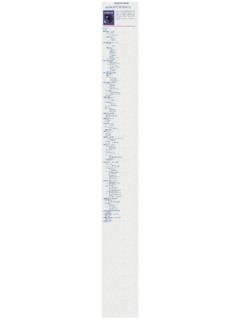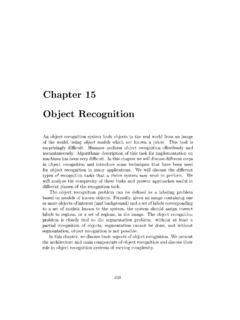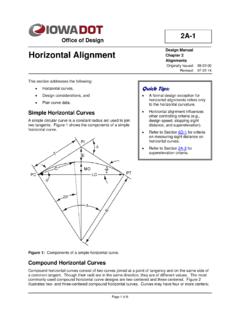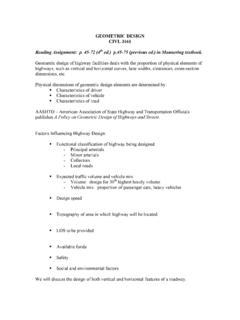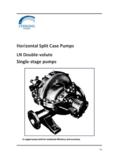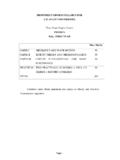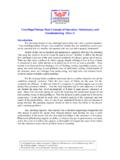Transcription of Contours - USF
1 Chapter 6 Contours Edges must be linked into a representation for a region boundary. This representation is called a contour . The contour can be open or closed. Closed Contours correspond to region boundaries, and the pixels in the region may be found by a filling algorithm. An open contour may be part of a region boundary. Gaps can occur in a region boundary because the contrast between regions may not be enough to allow the edges along the boundary to be found by an edge detector. The edge detection threshold may have been set too high, or the contrast along some portion of the boundary may be so weak relative to other areas of the image that no single threshold works everywhere in the image.
2 Open Contours also occur when line fragments are linked together-for example, when line fragments are linked along a stroke in a drawing or sample of handwriting. A contour may be represented as an ordered list of edges or by a curve. A curve is a mathematical model for a contour . Examples of curves include line segments and cubic splines. There are several criteria for a good contour representation: Efficiency: The contour should be a simple, compact representation. Accuracy: The contour should accurately fit the image features. Effectiveness: The contour should be suitable for the operations to be per formed in later stages of the application.
3 The accuracy of the contour representation is determined by the form of curve used to model the contour , by the performance of the curve fit 186 187 6. Contours ting algorithm, and by the accuracy of the estimates of edge location. The simplest representation of a contour is an ordered list of its edges. This rep resentation is as accurate as the location estimates for the edges, but is the least compact representation and may not provide an effective representation for subsequent image analysis. Fitting the appropriate curve model to the edges increases accuracy, since errors in edge location are reduced through averaging, and it increases efficiency by providing a more appropriate and more compact representation for subsequent operations.
4 For example, a set of edges that lie along a line can be represented most efficiently by fitting a line to the edges. This representation simplifies later calculations, such as determining the orientation or length of the line, and increases the accuracy, since the mean squared error between the estimated line and the true line will be smaller than the error between the true line and any of the edges. The first section in this chapter presents the elementary differential geom etry of curves in the plane. The second section gives a collection of techniques for calculating contour properties such as length, tangent, and curvature from the list of edges, without fitting a curve model to the edges.
5 The remaining sections cover curve models and techniques for fitting the models to Contours . Before proceeding, some terms must be defined. A curve interpolates a list of points if the curve passes through the points. Approximation is fitting a curve to a list of points with the curve passing close to the points, but not necessarily passing exactly through the points. In the following sections, we will begin by assuming that the edges provided by an edge detection algorithm are exact and will fit curves to the edge points using interpolation methods. The edges provided by edge detection applied to real images will not be exact. There will be some error in the estimated location of the edge.
6 Later sections will present methods for curve approximation. Definition An edge list is an ordered set of edge points or fragments. Definition A contour is an edge list or the curve that has been used to represent the edge list. Definition A boundary is the closed contour that surrounds a region. In this chapter, the term edges will usually refer to edge points. The edge orientation is not used by most curve fitting algorithms. In the few cases where the algorithm does use the edge orientation, it will be clear from the context that the term edges refers to edge fragments. 188 CHAPTER 6. Contours Geometry of curves Planar curves can be represented in three different ways: the explicit form y = f(x), the implicit form f(x,y) = 0, or the parametric form (x(u),y(u)) for some parameter u.
7 The explicit form is rarely used in machine vision since a curve in the x-y plane can twist around in such a way that there can be more than one point on the curve for a given x. The parametric form of a curve uses two functions, x (u) and y (u ), of a parameter u to specify the point along the curve from the starting point of the curve at PI = (X(UI),y(UI)) to the end point P2 = (X(U2),y(U2)). The length of a curve is given by the arc length: 1:2 ( dX) 2 (dY ) 2 du + du duo ( ) The unit tangent vector is p/(U) t ( u) = Ip' (u)I ' ( ) where p(u) = (x( u), y(u)). The curvature of the curve is the derivative of the tangent: n(u) = p"(u).
8 Consider three points along the curve: p(u + .6.), p(u), and p(u ). Imagine a circle passing through these three points, which uniquely determine the circle. In the limit as .6. --+ 0, this circle is the osculating circle. The osculating circle touches the curve at p(u), and the center of the circle lies along the line containing the normal to the curve. The curvature is the inverse of the radius of the osculating circle. Digital curves In this section, we present a set of algorithms for computing the elements of curve geometry, such as contour length, tangent orientation, and curvature, from the list of edge points. Slope and curvature are difficult to compute precisely in the digital domain, since the angle between neighboring pixels is quantized to 45 increments.
9 The basic idea is to estimate the tangent orientation using edge points that are not adjacent in the edge list. This allows a larger set of possible 189 DIGITAL curves tangent orientations. Let Pi = (Xi, Yi) be the coordinates of edge i in the edge list. The k-slope is the (angle) direction vector between points that are k edges apart. The left k-slope is the direction from Pi-k to Pi' and the right k-slope is the direction from Pi to Pi+k. The k-curvature is the difference between the left and right k-slopes. Suppose that there are n edge points (Xl, Yl), .. , (Xn' Yn) in the edge list. The length of a digital curve can be approximated by adding the lengths of the individual segments between pixels: S = L n V(Xi -Xi-l)2 + (Yi -Yi-l)2.
10 ( ) i=2 A good approximation is obtained by traversing the edge list and adding 2 along sides and 3 along diagonals, and dividing the final sum by 2. The distance between end points of a contour is ( ) Chain Codes Chain codes are a notation for recording the list of edge points along a contour . The chain code specifies the direction of a contour at each edge in the edge list. Directions are quantized into one of eight directions, as shown in Figure Starting at the first edge in the list and going clockwise around the contour , the direction to the next edge is specified using one of the eight chain codes. The direction is the chain code for the 8- neighbor of the edge.

